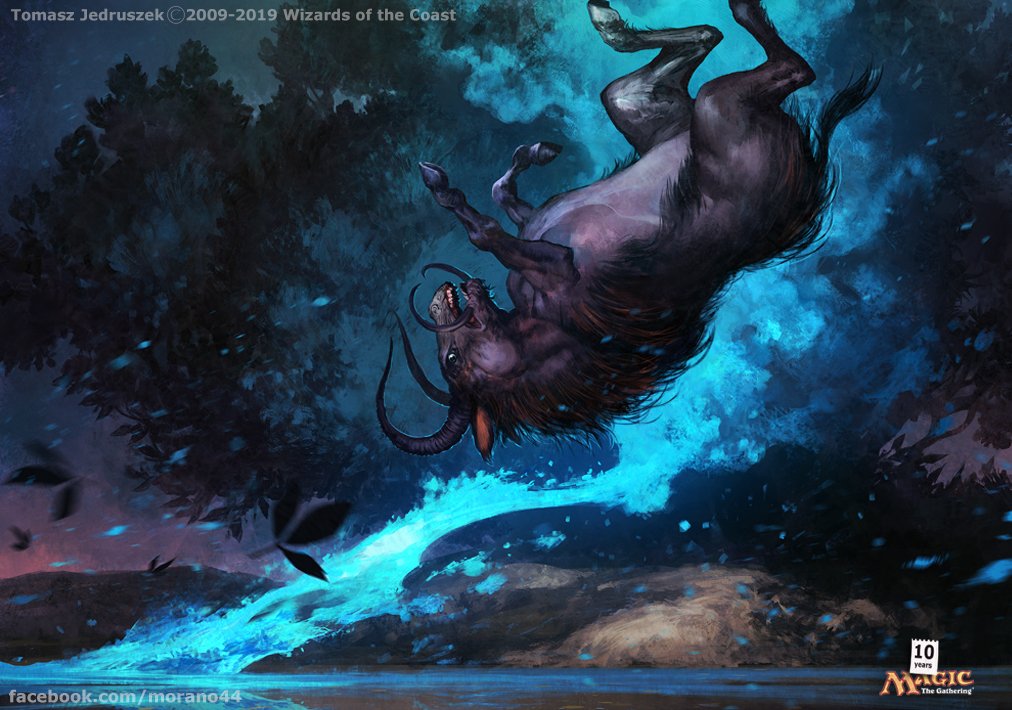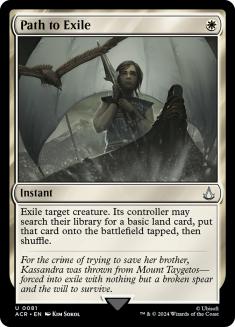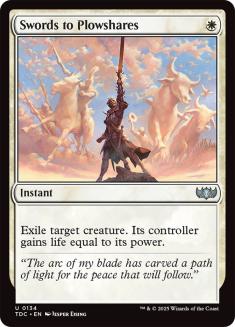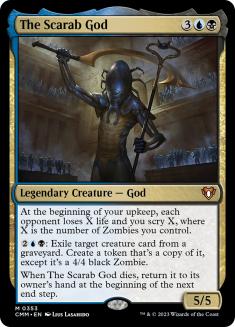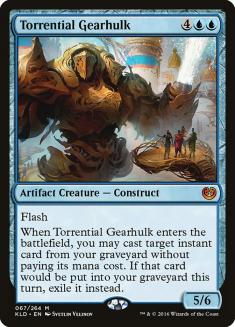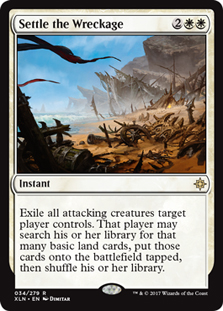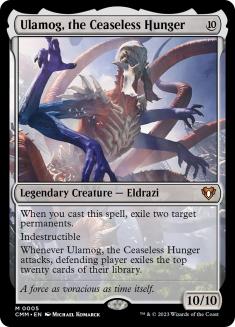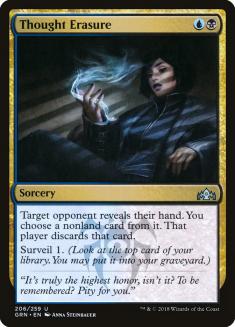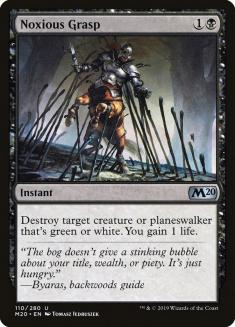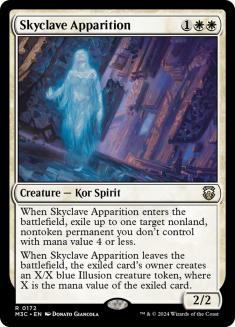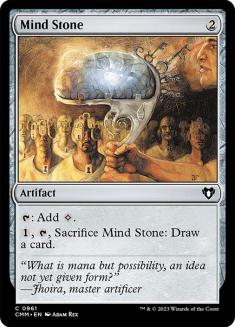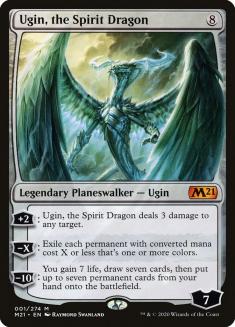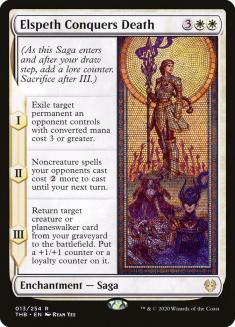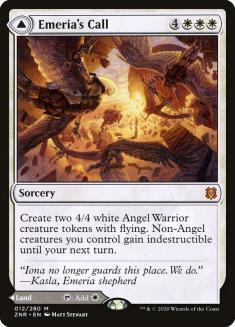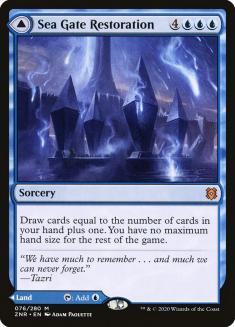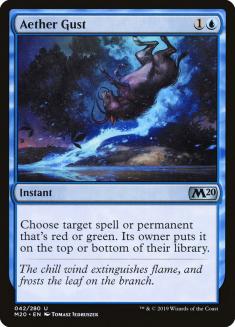Control is thriving in Historic. The Zendikar Rising Championship being won by Azorius Control was the icing on the cake, with most control fans fully aware of the archetype’s strength well before. Teferi, Hero of Dominaria will always be a force in competitive play, even seeing some action in Azorius Miracles in Legacy. The rest of the deck falls into place, only having a few weaknesses in the removal category.
Outside of Path to Exile and Swords to Plowshares, white has been completely starved of playable, instant-speed removal for decades. This is a fact that we have all had to come to terms with, often pushing me into a third color to complete the control puzzle. This is where Esper Control became a permanent part of my competitive life and my starting place when brewing for a new format. With the mana being atrocious for Esper Control in Standard, Historic, and Pioneer, I have had to make some tough choices on which two-color control deck to battle with.
Dimir Control is the king of targeted removal, consistency, and a smooth early-game. These attributes transcend formats, as many players have chosen Dimir Control as their weapon of choice in all competitive play. I have had similar success with The Scarab God and Torrential Gearhulk, compared to my time with Teferi, Hero of Dominaria and Wrath of God. In a perfect world, I would toss a few fetchlands in there and play a godly Esper Control deck, but it isn’t an option in Historic. Deciding which two-color combination to go with is challenging; however, either choice is strong in Historic.
While considering which direction to go in, many powerful cards get lost in the process. There are some control cards that are criminally underplayed, while others have been forgotten completely. There are ten of these lost souls that wander the Multiverse, looking to return to their control homes.
10. Settle the Wreckage
Wrath of God is the king sweeper of Historic. Even when looking at black, Languish and Extinction Event are heavily played in comparison to the powerful instant-speed option here. Settle the Wreckage has gone through its ups and downs, played as a staple at some points and completely forgotten at others. The playability of this card completely depends on the metagame, while the more typical sweepers can be dependable regardless of the opponent.
Settle the Wreckage has powerful interaction with Torrential Gearhulk in a control shell, making it an immediate contender for a comeback story. The format is currently bogged down with Uro, Titan of Nature’s Wrath and Hydroid Krasis, making this sweeper an undesirable option for control users. As Rakdos Sacrifice, Mono-Red Goblins, and Azorius/Orzhov Auras gain popularity, possibly after an Uro, Titan of Nature’s Wrath ban, Settle the Wreckage will be back in full force.
9. Ulamog, the Ceaseless Hunger
There are a few powerful monsters lurking in Historic, waiting to get the play they deserve. I may not gain any popularity by advertising this Eldrazi to the competitive world, but we all know what it’s capable of. Ulamog, the Ceaseless Hunger belongs in many more decks than it’s currently in, surviving in the format as a sometimes one-of in Temur Ramp. This threat should exist in any deck that produces an abundance of mana, especially in the Four-Color Control decks that disguise themselves as midrange on the tournament result page.
Ulamog is a bargain at ten mana. Growth Spiral; Uro, Titan of Nature’s Wrath; and a pile of card advantage options make this an easy inclusion at the top-end. Any dream that traditional control with Narset, Parter of Veils had of beating this deck would be shattered, as the Disallow count in control is dangerously low. The Four-Color Control decks out there will reach a higher level of power with their new Eldrazi captain at the top of the curve.
8. Thought Erasure
With the addition of Thoughtseize to Historic, other hand disruption has fallen by the wayside. Thoughtseize is the most powerful of the family, casting a shadow over all other options. I have noticed that many black-based control decks do not deploy four in the maindeck due to the life loss attached. They tend to lean heavily on the blue disruption while bringing in the hand disruption in the sideboarded games. Thought Erasure has been the solution to this maindeck problem since it was printed.
Thoughtseize is the better card without question; however, Thought Erasure has seen four-of play in every control deck that supports the colors. Hitting any card, taking zero damage, and adding surveil 1 for a minor cost increase is well worth it. In a format as slow as this, I still think Thoughtseize is the better card, but formats change. Folks that are worried about their life total and expanded usefulness should consider calling up this old friend.
7. Noxious Grasp
With all the powerful Simic-based decks running around, Noxious Grasp needs to be included in every deck that can support it. I often see one copy in the sideboard, which is far too low for a card that comes in against most matchups. Outside of Mono-Red Goblins and Rakdos Sacrifice, Noxious Grasp can be called upon to do some heavy lifting against the most powerful green and white threats out there.
Nissa, Who Shakes the World is cleanly answered by Noxious Grasp, as well as Teferi, Hero of Dominaria. Before the world found its renewed respect in Historic control, Noxious Grasp was played very rarely for good reason. Now that it hits two of the top archetypes of the format, it should be a significant part of the sideboarded plan for decks that can cast it.
6. Skyclave Apparition
It’s only a matter of time until Skyclave Apparition makes its splash in Historic. This universal catch-all has a very limited drawback, tossing the opponent a creature when it’s slain. That’s an acceptable loss for such a powerful effect, which has made it a staple in Modern already. At present, Cast Out and Teferi, Hero of Dominaria are the only answers Azorius Control has against resolved noncreature permanents. Skyclave Apparition adds to that toolbox, allowing more liberal cycling of Cast Out and providing breathing room for Teferi to draw a bunch of cards.
With the format flush with resilient threats, Skyclave Apparition should see an uptick in play. It may not fit in the traditional Azorius Control deck with no creatures but could see a home in a more proactive version down the road. Cards that define older formats usually have potential in the newer ones, giving me hope for Skyclave Apparition.
5. Mind Stone
Ramp in control has always been taboo, except in the case of Mind Stone. Using cards to advance mana, instead of disrupting the opponent, is risky business. Control is not known for ignoring creatures early on, taking a turn off, and surviving. Even when they did, using that to cast an early Wrath of God, drawing ramp in the late-game was often detrimental.
Mind Stone breaks the rules of ramp in control, providing a boost to mana early while drawing a card in the late-game. This is a powerful insurance policy for control players who are hesitant due to past experiences. Mind Stone is the perfect fit for decks with Torrential Gearhulk and can even find a home in reactive Azorius/Dimir Control decks. Casting the sweeper and then a planeswalker early, while having the ability to draw a card with it later, makes Mind Stone a strong control option in Historic.
4. Ugin, the Spirit Dragon
It took a bit for Ugin, the Spirit Dragon to see itself lead control in Standard, so I expect the same for Historic. Just like in Standard, a resolved Ugin is lights-out for most of the Historic metagame. When this planeswalker is powered by the ramp of Mind Stone and resurrected by the next card on the list, control has a hard time losing to anyone.
Ugin is the least impressive against some of the grindier decks, but it still a strong enough threat that must be answered. Against quicker decks that rely on a battlefield full of permanents to take us down, we have the answer that results in absolute threat destruction.
Having access to a reset button on a cluttered battlefield is a dynamic option control is always yearning to have. For years, Wrath of God played that role, but as more noncreature permanents got involved, the control answers had to evolve. Ugin is the evolution of that sweeper, always giving control players an escape in a normally inescapable situation. In control decks across the spectrum, Ugin will see more play in Historic.
3. Elspeth Conquers Death
This is an inevitable inclusion for Azorius Control. Outside of decks that use Lurrus of the Dream-Den, Elspeth Conquers Death should be a control staple in all decks that maximize its effects.
If there are no targets for it to return, its omission makes sense. Exiling a problematic permanent for five mana and then making the opponent’s non-creature spells cost a bit more is not worth it. Elspeth Conquers Death shines when those two occur, and then a Teferi, Hero of Dominaria crawls out of the graveyard with an extra loyalty counter.
Every Azorius Control deck I play, reactive or proactive, has a few of these in the 75. It’s easily the most powerful all-in-one spell for a control deck, regardless of what threat it exiles on the opponent’s side. Getting back fallen planeswalkers in any build of Azorius Control is an absurdly powerful ending to an already strong card, making it a no-brainer for control players. This was in close contention for the top spot, but the final two cards narrowly squeaked out a victory.
2. Modal Double-Faced Cards (Modal DFCs)
I must drag the soapbox from Standard to Historic for this one. Modal DFCs should be included in every deck, in every format, if they can be effectively used. Not only can these two modal DFCs be utilized in Historic control decks, but they also avoid the mana competition that fetchlands would create if they were legal. There are still some mana complications, due to the required basic land count and the strength of the Castles, but there is room for a couple of these in every control deck out there.
Emeria’s Call is a very strong addition in proactive Azorius Control, while Sea Gate Restoration fits in every build. As each day passes, more competitors have realized that Sea Gate Restoration is a powerful effect with a low opportunity cost that should be included in all blue-based control decks in Standard. That realization has not shifted to Historic yet, but it will.
The life loss of these two cards happens only if the mana is needed immediately, while the effect of each is very powerful. Giving control players lands early and big spells late is exactly what they need to thrive. These modal DFCs are number two on the list, not because they’re the most powerful, but because they should be the most carefree addition to every control deck out there.
1. Aether Gust
It pains me to have Aether Gust as the number one underplayed card of the format, but it had to be done. I painfully observed months of control only having it in the sideboard when every competitive deck had legal targets. The control mirror is where you get punished for having it maindeck, but that was too rare of an occurrence to be relevant. With more control decks on the rise, the risk increases; however, the payoff is too big to ignore.
The winning Azorius Control list from the Zendikar Rising Championship had one in the maindeck, which has been stock in recent weeks, but I still believe that number is too low. I have had two Aether Gust in each control maindeck and it has been a game-changer. But even the two copies maindeck were not enough for me, as I added a third to the sideboard to increase my win percentage against the flurry of red-based aggro and green-based midrange that has infested the MTG Arena metagame.
My use of Aether Gust is not groundbreaking, as this was common practice in Standard against a similar metagame. That said, there isn’t a control deck out there that should leave home without three copies of Aether Gust, with some in the maindeck, in order to defeat the top three decks of the format.

